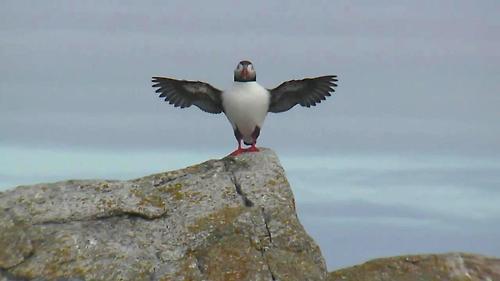Welcome to The Rock
On the Puffin Loafing Ledge Live Cam, there’s room to spread your wings.
If you are new – or just need a refresher on the Puffin Project – here’s a quick summary (and you can read more from Audubon here):
The National Audubon Society started Project Puffin in 1973 in an effort to learn how to restore puffins to historic nesting islands in the Gulf of Maine.
The Project began with an attempt to restore puffins to Eastern Egg Rock (pictured at right) in Muscongus Bay, about six miles east of Pemaquid Point. Puffins had nested there until the early 1880’s when hunters took the last survivors of this once-flourishing colony. The restoration of puffins to Eastern Egg Rock is based on the fact that young puffins usually return to breed on the same island where they hatched.
Young puffins from Great Island, Newfoundland (where about 160,000 pairs nest) were transplanted to Eastern Egg Rock when they were about 10 – 14 days old. The young puffins were then reared in artificial sod burrows for about one month. Audubon biologists placed handfuls of vitamin-fortified fish in their burrows each day and, in effect, took the place of parent puffins. As the young puffins reached fledging age (the time when birds leave the nest), they received leg bands so they could be recognized in the future.
After spending their first 2-3 years at sea, it was hoped they would return to establish a new colony at Eastern Egg Rock rather than Great Island. Because this was the first time an attempt had been made to restore a puffin colony, the outcome was unknown.
Between 1973 and 1986, 954 young puffins were transplanted from Great Island to Eastern Egg Rock and 914 of these successfully fledged. Transplanted puffins began returning to Eastern Egg Rock in June of 1977. To lure them ashore and encourage the birds to explore their home, wooden puffin decoys were positioned atop large boulders. These were readily visited by the curious young birds, which often sat with the models and pecked at their stiff wooden beaks. The number of young puffins slowly increased. In 1981, four pairs nested beneath boulders at the edge of the island and the colony has been growing ever since. As of 2013, there are now about 1,000 pairs of puffins nesting on five Maine islands.
Watch all the action and see all of the birds LIVE on the Live Cam here.
(Thanks to the great snapshot screen captures, Sheri Cochran!)




Trackbacks for this post